The Space Shuttle

Plot
The Space Shuttle, released in 1986, is a documentary film that captures the essence of the United States' space program's ambitious endeavors to develop a reusable spacecraft capable of carrying crew and cargo efficiently into low Earth orbit. The film offers an in-depth look at the conceptualization, design, and construction of the iconic Space Shuttle, a marvel of engineering that marked a significant milestone in the nation's space exploration endeavors. The Space Shuttle's origins date back to the 1970s, when NASA's plans to continue manned spaceflight beyond the Apollo program necessitated the creation of a new spacecraft capable of withstanding repeated reentry into the Earth's atmosphere. Engineers and designers began brainstorming ideas, leveraging emerging technologies to build a reusable vessel that would reduce launch costs, minimize the need for expensive launch vehicles, and facilitate longer-term space missions. This documentary film delves into the minds of the visionary engineers, scientists, and technicians, showcasing the creative process behind the conceptualization of the Space Shuttle. The idea was not simply to develop a one-time use craft, but to design a complex machine that would be used multiple times, with its components subjected to incredible stresses and temperatures during ascent, space travel, and landing. The challenge was monumental, with every system requiring innovative solutions to ensure the crew's safety and the shuttle's successful performance. One of the standout aspects of the Space Shuttle was its reusable heat shield, designed to withstand the intense friction caused by atmospheric reentry. Made from ceramic tiles and felt-backed blankets of K-13 phenolic impregnated resin, this shield provided the necessary thermal protection for the shuttle's delicate systems. The film explores in detail the development of this groundbreaking technology, highlighting the trials and errors encountered during its development and testing. Another critical component of the Space Shuttle was its powerful main engines, each capable of producing 418,000 pounds of thrust. These engines used liquid hydrogen and liquid oxygen as propellants, with the former being a major source of complexity due to its high reactivity and low storage density. The film illustrates the engineers' struggles to design and manufacture these engines, overcoming issues such as thermal shock, propellant management, and combustion instabilities. Throughout the documentary, archival footage, interviews with NASA engineers and astronauts, and computer-aided graphics vividly portray the sheer scale and complexity of the Space Shuttle project. From the first concept drawings to the final assembly of the orbiters, including the ill-fated Columbia, this film meticulously chronicles every step of the development process. Key milestones, such as the first shuttle flight in 1981, are covered in the documentary, providing an intimate look at the trials and tribulations faced by those responsible for building this incredible machine. By taking viewers through the design and construction phases of the Space Shuttle program, The Space Shuttle documentary film masterfully captures the essence of human ingenuity, perseverance, and creativity that defined this remarkable period in space exploration. Through the stories of the individuals involved in the project, we gain a deeper understanding of the challenges faced and the groundbreaking solutions developed, solidifying the Space Shuttle's reputation as one of the most impressive feats of engineering in modern history.
Reviews
Recommendations


